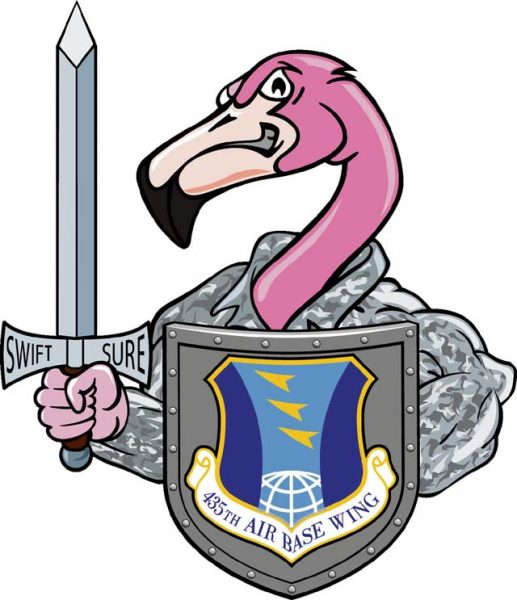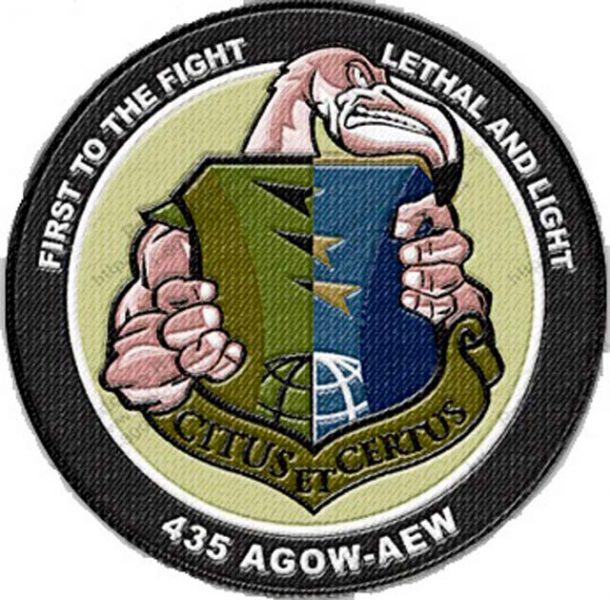
Flamingo Flyer newsletter banner for 435th Troop Carrier Wing.
When I arrived at Ramstein, I asked myself and I have been asked a number of times by others since, “Why a pink flamingo?” What does a pink flamingo have to do with the 435th Air Ground Operations Wing and the 435th Air Expeditionary Wing?
The answer is found in a patchwork of the following: natural history, where the wing was stationed for some 18 years, the popularity of a particular plastic yard ornament, and the humor of Airmen.
Pink flamingos, also known as greater flamingos, have been around for tens of millions of years. They live in tropical and sub-tropical regions and migrate around the globe, often between intertidal estuary and lagoon habitats. Mainland Florida, however, has not been one of their habitats for at least the last few hundred years.
Despite this fact, pink flamingos have been associated with Florida, an association which may have started with the naturalist painter James Audubon, who spotted one of the birds migrating through the Florida Keys in the late 19th century. In the 20th century, for better or worse, pink flamingos, alongside seashell lamps, became unofficial icons for the state of Florida.
The 435th Troop Carrier Group was activated in February 1943 and flew in all of the major World War II European Theater campaigns. With the war’s end and the resultant drawdown of forces, the 435 TCG was inactivated in November 1945.
When the 435 TCG was reactivated in 1947, it was assigned to the recently created Army Air Forces Air Reserve Program and stationed at Morrison Field in Palm Beach, Florida. The group was reorganized as the Air Forces Reserve 435th Troop Carrier Wing in May 1949 and moved to Miami International Airport, Florida, where it remained until 1960. In 1960 it was moved once again, this time to Homestead Air Force Base, Florida, where it remained until the wing was inactivated in December 1965.
The unit spent its 18 years with the Air Force Reserve flying out of Florida, largely by Floridians. Sometime in the early 1950s, these Floridian Airmen gave their unit the moniker of “The Flamingo Wing” and named their wing newsletter the “Flamingo Flyer.”
So how did the graceful flamingo of the 435 TCW become the flamingo of the 435 AGOW and 435 AEW as depicted in our 21st century offices and operating locations, and on our morale patch and shirt?
In 1957 a business in Massachusetts, Union Products, gambled on the marketability of a kitschy pink flamingo and began to manufacture its first plastic pink flamingo yard ornament. Since then, Union Products has sold some 20 million plastic pink flamingos and in that process defined for the public what a pink flamingo should look like. This yard ornament representation continues to capture the popular visual image of the pink flamingo.
It is also this pink flamingo yard ornament that a 435th Air Base Wing Airman in the early 2000s poked at until it became very angry. His particular design took a mundane flamingo and made it into an imposing flamingo. After winning a wing design competition, this flamingo was incorporated into a morale patch of the 435 ABW.
This flamingo was updated once again following the 435 ABW redesignation as the 435 AGOW in 2009 and the 435 AEW activation in 2013. The modification reflected the change in the wing’s mission from base operations to contingency response and joint battlefield operations and as the activation of the only expeditionary wing of the 17th Expeditionary Air Force.
Circling back around to the initial question of “why a flamingo,” we find that the answer is rooted in the patchwork of the often ironic and absurd tone of Airmen humor, commercialism, the heritage of the unit and nature.This is why, today, the morale patch of the 435 AGOW and the 435 AEW and the bright pink morale shirt of the 435 AGOW Headquarters staff have an angry pink flamingo on them and why there are two plastic pink flamingos standing post at the entrance to the 435 AEW operating location at Chabelley Airfield, Djibouti.




